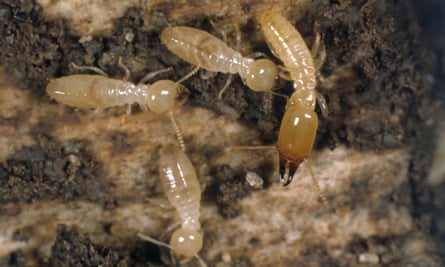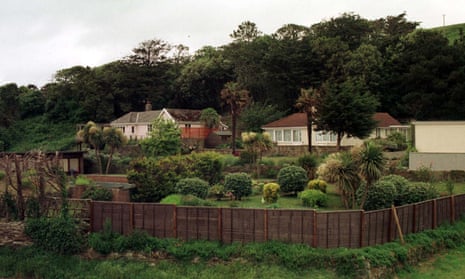In 1994 , a bungalow owner in Devon called pest control to report that a mysterious “white ant” had chomped through her conservatory. Investigations eventually revealed the culprit was in fact a colony of millions of subterranean termites, the first and only colony ever recorded on UK soil.
The call marked the beginning of a 27-year saga involving hundreds of thousands of pounds of public money and considerable headaches for the property owner and her neighbours in Saunton on the north Devon coast.
Many experts thought the UK’s Termite Eradication Programme (TEP) was doomed to failure. Once imported, usually in something as innocent as a wooden wine crate or an antique pine wardrobe, the tenacious insects inevitably triumph and become endemic, thanks to their superior burying and reproduction skills.
But now in Devon, human ingenuity and British bloody-mindedness have prevailed. After no signs of termite activity were detected for the past 10 years, the Saunton termite colony has officially been declared dead by a panel of international experts, saving the nation from a future where homeowners have to worry about termite infestations as well as wasp nests and rising damp.
A final field inspection in May found no signs of termites in a zone 100 metres long and 30 metres deep, and the TEP is now in “decommissioning mode”, said Dr Ed Suttie, the termite terminator who has been involved with the TEP since it began in 1998 and has run it since 2003. No other country has ever won the termite war, he said: “It’s a world first.”
There have been false dawns before in this battle of the beasties. Going into the new millennium there were no sightings of the termites for nine years. Then their beadlike antennae were again spotted rooting around in the soil, resulting in the eradication and monitoring programme being extended repeatedly until this year.
The colony had made its home under two neighbouring bungalows, which were effectively condemned by the invaders. In 2012 one of the owners applied to demolish her property and start again, but was denied planning permission after a two-year battle.
So crucial was the matter deemed to national biosecurity that the final decision was taken by the then communities secretary, Eric Pickles. He refused it on the grounds that the demolition and construction work could risk the termites spreading to a wider area, causing “potential catastrophic economic, environmental and social consequences”.
A compromise was struck whereby she was allowed to build an annexe that Suttie says is “the UK’s only termite-proof building”. Burning down the infected buildings was not an option, he explained: “Termites were not actually living in the house – the wood in there was just their food source. They live underground, often many metres under the surface.”
Suttie said both property owners had shown “amazing cooperation” over the decades, banned not just from most home improvement but also from removing any soil or wood from the site.
They also had to let TEP officials plant “timber bait” in their gardens – essentially wooden stakes made out of aged pine, termites’ favourite food, which they could monitor for nibbles. Termite eradication involved the targeted deployment of “insect growth regulators”, a kind of hyper-intelligent insecticide that would stop the termites reaching maturity and reproducing.
Had successive governments since 1998 not invested considerable amounts of public money in the effort, it could have been a very different story, said Suttie. Termites could have become endemic, eating their way through floor boards, door frames and beams across southern England, just as they do in Australia, parts of North America and southern Europe.
The stakes are high: each year, termites cause more than $5bn (£3.8bn) in property damage in the US, according to the National Pest Management Association.
Though the termites were first confirmed in Saunton in 1994, Suttie believes they may have been imported to the site as many as 70 years earlier: “Anecdotally, we’ve heard stories of gardeners referring to white ants and a greenhouse that had to be replaced.”
Nick Harvey, who was the local Liberal Democrat MP from 1992 to 2015, remembers the “great anguish” of the bungalow owner who discovered the colony. His constituent believed a previous occupant had accidentally imported the termites in soil brought from the Canary Islands via some non-native plants, he said.
Damian McBride, a special adviser to the shadow foreign secretary, Emily Thornberry, who drew attention to the termite war in a Twitter thread, said he thought Suttie and others should be given honours for their unglamorous but essential public service.
“What’s the moral of the story?” he asked. “You can make up your own, but for me, this is public service in its finest form – unseen, largely unknown and rarely heralded – but done with selfless dedication year after year simply because of what would happen to the rest of us if it wasn’t.”
Engineers of destruction: termites v towns

In forests and grasslands of their native tropics, termites are regarded as “soil engineers” that are vital to the maintenance of soil structure and ecosystem balance, according to BRE, which has run the government’s Termite Eradication Programme since 1998. But imported into urban environments, they are considered pests because of their ability to severely damage timber in buildings.
Subterranean termites – the kind that caused havoc in north Devon – are now endemic in southern Europe, thanks to globalisation and the warming climate. If you live in a termite-infested area in France, you must, by law, supply a “termite-free” certificate when you sell a house and any building work must be certified termite-proof.
Much of the UK is too wet for a subterranean termite colony to establish. But unluckily for the bungalow owners in Saunton, their properties were built on very light, sandy and well-draining soil among maritime pine trees that termites love. The houses were also built using a lot of pine timber, a delicacy for the greedy insects, which can chomp away undetected for months, hollowing out wood from the inside.
Sometimes mistaken for white ants, worker termites are typically 4-6mm in length, are pale or whitish in colour, have beadlike antennae and lack a “waist” (a constriction of the first or second abdominal segments). A colony can form in the space of a match box but can be vastly bigger, as in the Devon case, comprising numerous “mud tubes” or tunnels that connect food sources and nesting sites.
